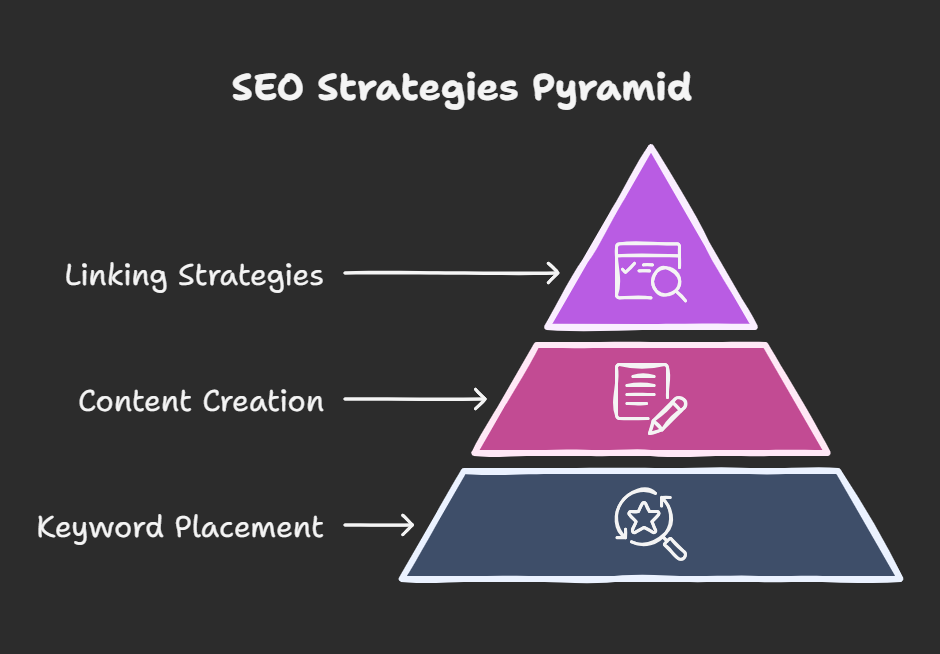- March 12, 2025
- by usmanali09132@gmail.com
- Uncategorized
- 0 Comments
SEO can help drive organic traffic to your blog, making posts easier for readers to locate through search engine results. Below is a step-by-step guide that can assist in this effort.
What Are Effective Keyword Placement Strategies for Blog SEO?

Keywords must be deployed strategically if you hope to gain top rankings on search engines. Here’s how you can optimize their placement:
Prioritize Keyword in Title (Ideally Near the Beginning)
For search engines to understand the relevance of your post, your primary keyword must appear near the start of the title. Search engines rely on this feature to recognize the keyword’s importance. Otherwise, your keyword won’t get recognized!
Subheading Keywords (H2-H3) for Search Engine Indexation (SEI)
Subheading keywords can increase both SEO rankings and reader navigation capabilities. This benefits both parties by providing context about what the page contains while also helping readers quickly locate the information they need. Including keywords throughout the content improves SEI indexation capabilities.
Body Text
Ensure that your keyword appears naturally throughout the body text. An optimal keyword density level should fall between 1-2%. Avoid overstuffing your content with keywords as it can negatively affect readability and user experience.
Meta Description and URL
To increase indexation rates, include relevant keywords in both your meta description and URL. This can significantly boost your SEO performance and improve your chances of ranking higher.
Images Alt Texts
When uploading images to your website, use keywords as alt texts for optimal SEO and accessibility. This can help improve both search engine ranking and accessibility for visitors who rely on screen readers.
LSI Keywords
Latent Semantic Indexing (LSI) keywords are important for providing search engines with context about what your post covers. Naturally incorporate LSI keywords throughout your content to give search engines a deeper understanding of your topic. However, be mindful not to overuse them, as they should feel natural within the content.
How Can I Write Engaging Content That is SEO Friendly?
Content that speaks both to readers and search engines is paramount. Here’s how you can achieve it:
Understand Search Intent
Utilize specific keywords to understand what users are searching for and create content that directly answers those inquiries. This will help you align your content with the audience’s needs.
Write for Readability
For optimal readability, consider employing short paragraphs, bullet points, and varied sentence lengths. This helps improve the readability score and keeps readers engaged. Tools like Hemingway or Grammarly can assist you in monitoring readability.
Engaging Introduction
A compelling introduction is essential for reducing bounce rates and increasing engagement. Begin your content by directly responding to user queries or pain points. This approach can keep readers on your page longer, decreasing bounce rates while boosting engagement.
Utilizing Heading Tags
Break your content down into digestible sections using H2, H3 heading tags. These improve the user experience and allow search engines to index your page more thoroughly, which ultimately boosts SEO.
Include Call-to-Action (CTAs)
Encourage readers to take action by including CTAs that prompt them to subscribe to your mailing list or read another relevant blog post. This can help keep users engaged and reduce bounce rates.
Topic Clustering
Develop content around an overarching theme by creating pillar pages and linking related blog posts. This approach not only improves SEO but also enhances user navigation across your blog.
Internal and External Links Explained
Internal and external links are crucial for improving the SEO of your blog. Here’s why:
Internal Links
Internal linking helps search engines index your blog more rapidly while keeping visitors on your website for longer periods, which increases conversion potential. Create an organized internal linking structure to make it easy for both users and search engines to navigate your site.
External Links
Using outbound links from trusted sources benefits your readers and establishes trust. Linking to authoritative websites can also signal to search engines that your content is relevant and well-researched.
Backlinks
Securing quality backlinks from credible external websites boosts your domain authority and search rankings. Backlinks help solidify your website’s credibility and increase your chances of ranking higher on search engine results pages.
Enhance Site Navigation
An organized internal linking structure enhances navigation, making it easier for both visitors and search engines to locate content on your website.
Follow these steps to create blog posts that not only draw organic traffic but also improve the search rankings of your blog. By prioritizing both reader needs and SEO best practices, you can craft engaging content that performs well on search engines while keeping your audience engaged.




